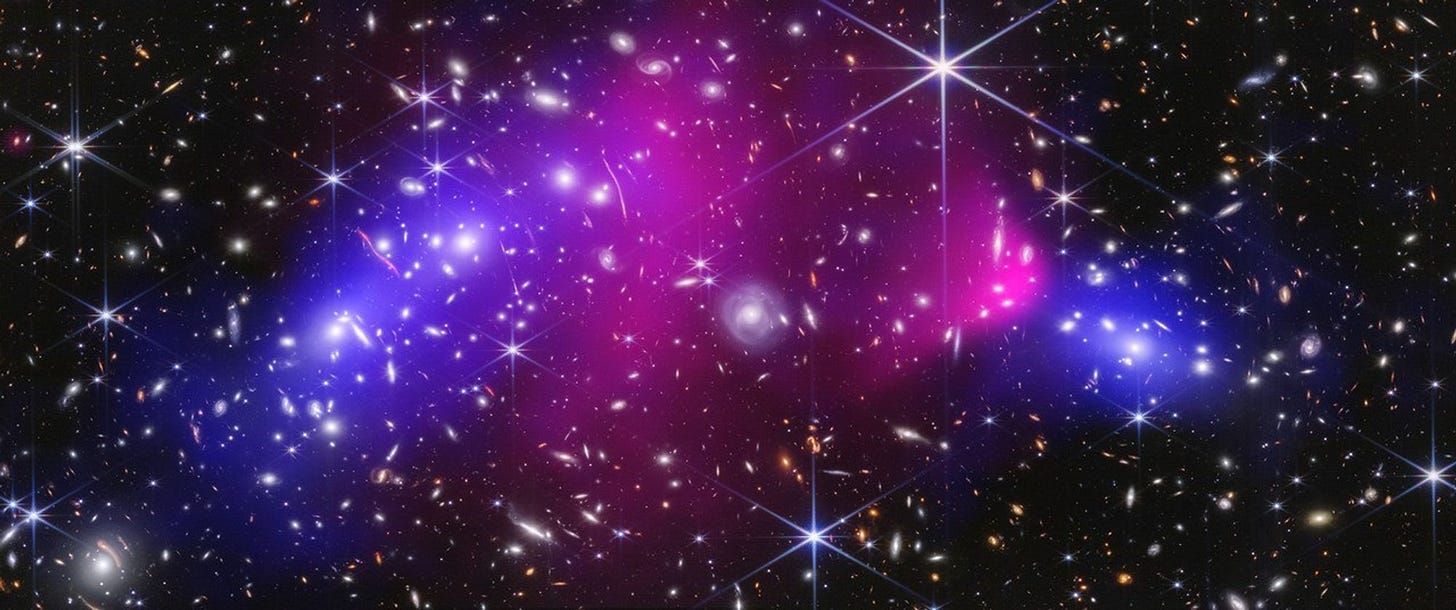
Seeing the invisible has been a recurring theme in this column as of late. It turns up again this week as we catch a fleeting glimpse of dark matter, the mysterious substance that helps shape the universe.
Dark matter holds this name for two reasons: because it is a form of matter that does not interact with visible light or any other electromagnetic radiation, and because we have no idea what it really is.
The term dates back to 1933, when Fritz Zwicky — an astrophysicist who observed the motion of some galaxies to be inconsistent with gravitational theory — coined the phrase. By accounting for unseen mass — dark matter — within these galaxies and galaxy clusters, Zwicky was able to resolve these gravitational inconsistencies, and named what he observed “dark matter.” Work by astronomer Vera Rubin and others in the 1970s helped confirm dark matter’s existence. Both astronomers have been memorialized for their work to advance our understanding of dark matter, with an observatory christened after Rubin, and an ongoing survey at Palomar Observatory bearing Zwicky’s name.
It's possible that our theories of gravity are just wrong, or that invoking the invisible to explain the universe is a bad idea. While our existing ideas about one or both of these things may prove to be incorrect, dark matter is definitely real.
As far as we can tell, dark matter interacts with the rest of the universe only through gravity. Just like “regular” matter, dark matter warps space, and the way space is warped dictates how both matter and light move. Very massive objects warp space to a degree we can observe visually. That means the more warped an area of space appears, the more mass we assume to be present in that area.
A new image from the NASA/ESA/CSA James Webb Space Telescope (JWST) uses this idea to map, in unprecedented detail, dark matter’s distribution in a pair of massive galaxy clusters.
The two galaxy clusters, collectively known as the Bullet Cluster, are about 3.9 billion light-years from Earth. JWST’s image, captured in near-infrared light, shows thousands of galaxies, many of which appear stretched and twisted like ribbons — a result of the cluster’s enormous gravity.
The blue areas on either side of the image show what’s presumably a concentration of dark matter around each galaxy cluster — a hypothesis based on gravitational distortions present in the JWST data.
The two clusters collided in the cosmically recent past, passing right through each other. During the collision, interactions between immense molecular clouds created a colossal amount of hot gas between the clusters. Using data from the Chandra X-ray Observatory, the hot gas is visualized as the pink area in the center of the image.
Take a few moments to study this remarkable image. How many galaxies do you think are in it? How many stars?
The Weekly Roundup:
The Morning Sky
Venus, brilliant queen of the morning sky, blazes brightly in the east before dawn. Saturn, a giant yellow ball of gas 1 billion miles from Earth, is halfway up the southeastern sky in the early morning. The Moon pays a visit to Saturn on Wednesday morning.
The Evening Sky
Mercury is tough to spot: low on the western horizon after sunset early in the week, and disappearing from view by the end of the week. Mars glitters like a ruby in the western sky as darkness falls.
Dan Price is a NASA/JPL Solar System Ambassador and informal educator. Have a question about astronomy or space science? Send an email to dan@starpointestudio.com and it might be featured in a future column.




As for how many galaxies are in this image, I counted all the distinctly 'galaxy-shaped' objects in a half-inch slice on my screen and then multiplied, then arounded up. I still feel like my result of about a thousand is grossly underestimated. And for stars, "billions and billions".
Fritz Zwicky definitely belongs on the pantheon of Astronomers with Cool Names